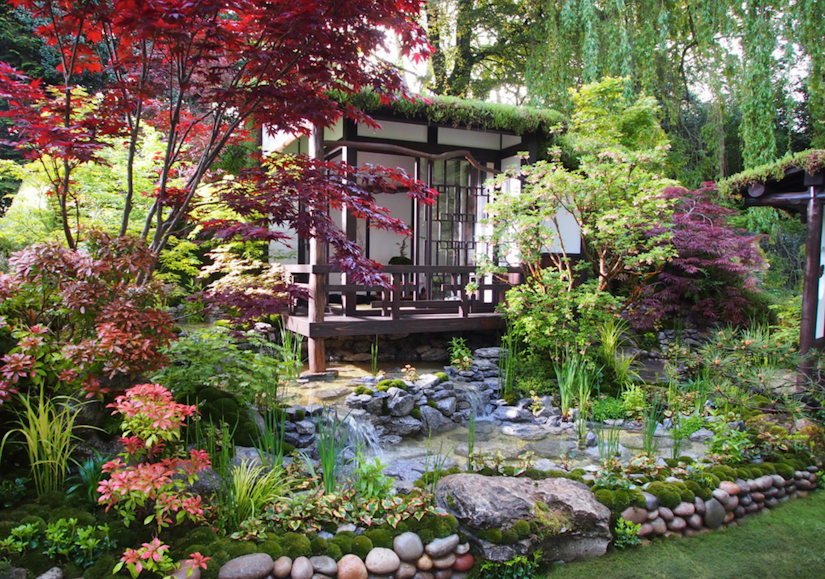Table Of Content

The koi pond can serve as the central element, uniting other garden components, and creating a harmonious atmosphere. Complement this with surrounding greenery, a meditation area, or a pagoda statue for a complete Zen garden retreat. As the pebbles connect to each other, your garden will offer tranquil moments in a serene atmosphere. Consider complementing this with other Zen elements like a meditation space or a flowing stream for a complete Zen backyard experience. ‘My Nandina has moved house with me about four times now, and if it starts getting too big, it can be easily pruned. Go for simple styles – think stone bowls, or how about a Shishi Odoshi?
Simplify the color palette.
Begin by forming island gardens with grass, plush moss, and meticulously arranged rocks to create an aesthetically pleasing pattern. ‘Think raked gravel instead of grass, to interpret water ripples,' she adds. Larger rocks can be used to resemble mountains, or islands, rising from the ‘water’ below. Light, small-sized gravel works well, and then, using a hand-held rake, create swirls and lengths of patterns – get creative! You can change the raked design every time, depending on how the mood takes you. We say give Japanese gardens a try–and some space in your backyard!

Japanese garden ideas for small spaces that will bring Zen to Your Home
Complement the fountain with well-placed stones, lush greenery, and strategic lighting to create a harmonious Zen backyard retreat. If you’re moving toward minimalism in a garden, consider dedicating a space to a dry garden with no plants at all. “You can use a rake to create patterns in the sand, and change the patterns from time to time to make the garden feel new,” says Keane.
25 Refreshing Water Feature Ideas for Your Landscape - Better Homes & Gardens
25 Refreshing Water Feature Ideas for Your Landscape.
Posted: Mon, 29 Aug 2022 07:00:00 GMT [source]
Deter Deer Naturally
‘Accolade’ has masses of semi-double flowers and a broad canopy, which you could tuck further plants and even seating beneath for a delightful view. It also benefits from autumn-colour, with its foliage turning a spectacular orange. For a dramatic spectrum of colour throughout the seasons, try Acer shirasawanum ‘Jordan’. It has orange-yellow leaves in spring, which turn to a refreshing zing of green in summer, followed by a deep red in winter.
And they wouldn’t even need a master green-thumb to maintain. A Japanese tea garden is laid out in front of a traditional teahouse. That’s because of the need to perform certain customs of the Japanese tea ceremony. There are many styles to choose from—a Zen oasis, tea garden, floral or mossy landscape. First select the style you want and see how you can lay it out. Japanese gardens are popular for their bonsai—the art of creating miniature replicas trees.
You are ready to stroll or meditate in your carpeted moss garden. Perfect for smaller areas, this garden can be made using rocks with sharp edges. Create an encasement, as pictured below, and fill the area with sand.
nobu hotel palo alto brings japanese tradition to california with garden oasis - Designboom
nobu hotel palo alto brings japanese tradition to california with garden oasis.
Posted: Wed, 16 Aug 2023 07:00:00 GMT [source]
Design Elements in Japanese Gardens
Essential in achieving this Japanese style garden is to include the principles and elements which are everywhere in Japanese culture. Since this plant comes in so many sizes, shade, shapes, you can build a rich garden wholly comprised of Hostas. The naturalized types found throughout Japan are natural and authentic, especially compared to the North American hybrids. You will find these trumpet-shaped flowers in various hues of yellow, salmon, pink, red, white, and violet.
Draw lines in the sand.
Make a waterfall and listen to the sound of it splashing over the rocks. In a really quiet space, the clacking sound of a shishi odoshi can be particularly soothing. The boundary should be visible but doesn’t have to hide the surrounding landscape.
Don't overdo it though, just one or two flowering shrubs will do the job. It may be a cherry tree in blossom or an azalea, camellia or rhododendron (go for compact Rhododendron yakushimanum for smaller gardens) in bloom. With their exquisite designs and thoughtful planting, Japanese gardens enchant and intrigue.
Instead, he replaces this traditional material with natural stone, carving, and hand-chiseling unique water features, or with copper pipes. Using stone fountains and adapting his plant choices ensures the garden will stand the test of time in SoCal, even in drier years. Designing a Japanese garden in a small space can be a captivating and rewarding experience. By embracing simplicity, carefully selecting plants, harmonizing hardscape elements, and achieving balance through nature, you can create a serene oasis that captivates the senses. Follow our expert tips and creative ideas to design a breathtaking Japanese garden that stands out and inspires awe, even among other websites on Google. To cultivate Japanese Iris in your garden, it is essential to provide the right growing conditions.
An easy way to introduce tumbling water is with a water feature such as series of interlocking smooth ceramic bowls. As well as adding a sculptural detail, you can enjoy the sensory experience of the sound of trickling water. This will bring a feeling of peace and calmness to your outdoor oasis. It has a tall, upright habit that adds impact, especially if the lower leaves are stripped off to expose more of the canes. Consider a shishi odoshi (deer scarer), which makes a satisfying clacking sound as it fills with water and empties again. A Japanese garden is a retreat from the world to appreciate nature, so it should have a clearly defined border that separates it from its surroundings.
One thing to note is that the bridge is a symbolic bridge and even your garden does not have any water element to serve as pond or waterfall, you can still install the garden bridge. The Japanese garden is a miniature and idealized view of nature and hence no matter how small space your garden is, you could always implement this style of garden. Have you ever visit a Japanese Garden without seeing the koi fish? In fact, the fish is used as a decorative element in conjunction with the water elements. According to Wikipedia, the use of fish in the garden is rooted back to China more than a thousand years ago i.e. goldfish was introduced to Japan in the 16th century. For this reason, water is an indispensable element in Japanese garden.
B Implementation of a garden environment should be beautiful in its aesthetics as well as fitting to the environment. We at Zen Japanese Landscape strive to bring a more environmentally clean garden design that is simple and yet beautiful, utilizing the natural elements in our design. The first is called tsuri-doro which literally mean hanging lantern. It is important to select the authentic hand-carved natural granite stone lantern that will add a tranquillity touch to your outdoor oasis. The vertical rough rock is used to represent mountain while the flat ones serve as stepping stones.
These gardens often feature carefully raked patterns in the gravel and are designed to inspire meditation and contemplation. Karesansui gardens are minimalist in design and typically have no water features or plants. Zen Buddhism also plays a significant role in Japanese garden design.
To create harmony, the elements of air, earth, water and fire should all be represented. Lara also recommends to pick plants which will provide interest in different seasons. For instance, Prunus 'Kanzan' will provide pretty pink blossoms in spring, but also striking yellow-orange foliage in autumn. Acer palmatum is another choice for autumn interest, with its red-orange leaves. White hydrangeas make a stunning accent throughout the summer months – our guide on how to grow hydrangeas is full of useful tips. Choose some plants that are evergreen for year-round interest and structure, she says.
Plants are carefully chosen for their ability to create a sense of balance and harmony and are often pruned and shaped to create unique and artistic forms. Tsukiyama gardens are designed to emulate the natural landscape of hills and mountains. These gardens often incorporate artificial hills and mounds, which are carefully shaped and covered with plants, trees, and rocks. Tsukiyama gardens create a sense of depth and perspective, with paths winding through the hills and leading to different scenic spots.












